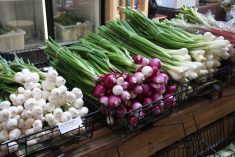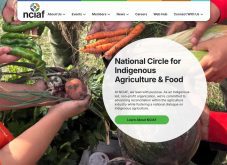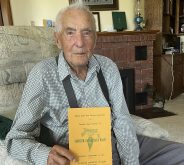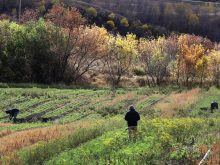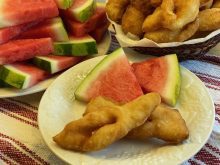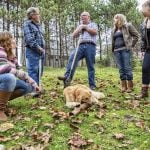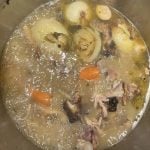During the first and second world wars, many Canadian servicemen fell in love and married British and European women. These women came to be known as “war brides.”
It is estimated that 25,000 Canadian servicemen married British women during the First World War and an estimated 48,000 women married Canadian servicemen during or following the Second World War.
These war brides were mostly from England, Ireland and Scotland, but a few thousand were from Holland, Belgium, Italy, France and Germany.
Read Also
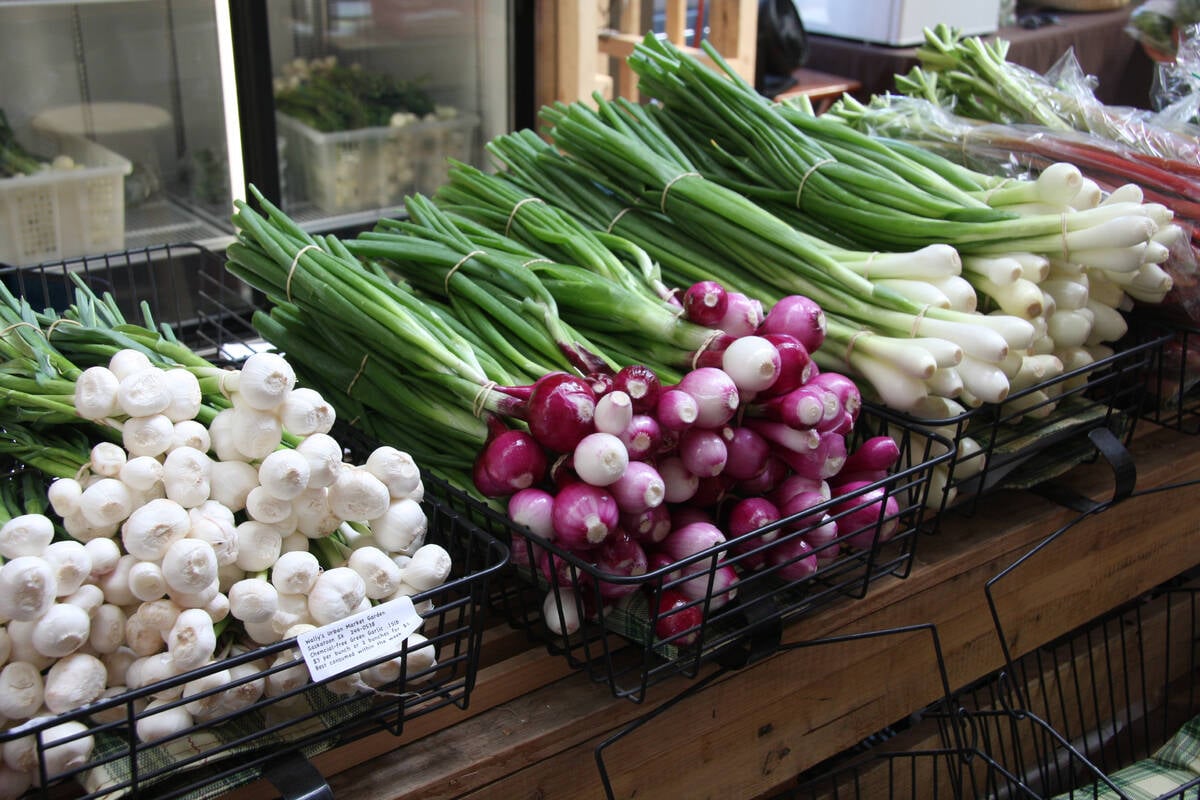
Starting a small business comes with legal considerations
This article sets out some of the legal considerations to start a business to sell home-grown product, such as vegetables, herbs, fruit or honey.
At the war’s end, the Canadian government’s priority was to return its servicemen and women to Canada. By early 1946, troop ships were reassigned to transport war brides and their 22,000 children to join their husbands and fathers in Canada.
During the war, these young women had lived through air raids, bombings, blackouts, food and clothing rationing and losses of home, community and family. They were leaving behind families that they might never see again.
In addition, these brave young women were going to a country they knew very little about to meet their husband’s family and start a new life. For the families of the war brides, they were losing their daughters to the Canadian servicemen.
Many of the war brides were veterans themselves, and they brought their skills and interests with them. As they adjusted to their new life, they got involved in their communities and used their talents.
A memorial pedestal recognizing the contributions of war brides to Canadian society was unveiled in Regina’s Victoria Park on July 11, 2024. The pedestal is beside the Regina Cenotaph.
Canadian War Brides and Families (CWB&F) was represented at the ceremony by Lynn Martin and Bernice Fells, both daughters of war brides.
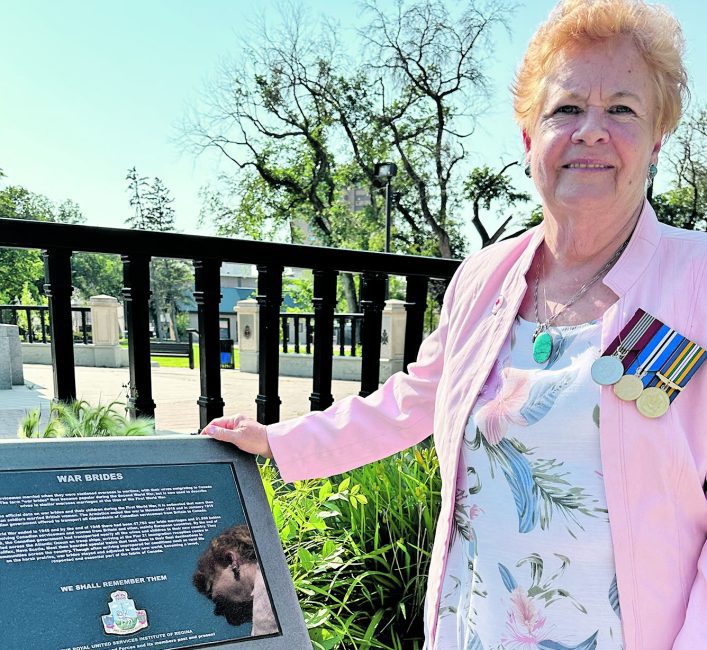
“Eighty per cent of the Canadian war brides came to Saskatchewan and Alberta because they married farmers,” Martin, president of CWB&F, said during the service.
Martin also honoured Jean Fells and Doreen Kamas, two war brides who were instrumental in preserving the legacy of women like them in Canada. Both Fells and Kamis had recently passed away at the age of 97. There are only a very few war brides left in Saskatchewan.
“The loss of these women makes recognition of their stories all the more significant,” Martin said.
Saskatchewan Lt.-Gov. Russ Mirasty honoured the war brides during the ceremony.
“These women deserve to always be remembered.… These remarkable women chose to leave everything they knew to travel to a new country and start a new life,” Mirasty said.
“The brides became Canadian citizens who supported their husbands, raised children and contributed to our society, our economy, our country. Our nation was forever changed.”
Many war brides left European cities where they were accustomed to running water, electricity, bakeries and laundries. When they arrived on the Prairies, it was a bit of a shock.
Martin’s grandfather in England was a watchmaker, and so the home her mother left was well fitted out with proper indoor heating and plumbing.
When her mother arrived in Davidson, Sask., in April 1946, her in-laws came to meet her at the train with a horse and sled and took her to a farm with outdoor plumbing, a booker stove for heating the farmhouse and no power. Electricity didn’t come to the farm for another 10 years.
For many war brides, the isolation on Prairie farms was their most difficult challenge.
In the spring of 1975, Gloria Brock of Abernethy, Sask., and two other Saskatchewan war brides organized a day in Regina to celebrate the arrival of the war brides in Canada 30 years earlier. The event was so successful the participants wanted more opportunities to get together.
Brock pursued this, and on June 9, 1975, 35 war brides attended the founding meeting of the Saskatchewan War Brides Association. Through the next 25 years, Gloria was instrumental in the creation of war bride organizations across Canada.
For about 40 years, annual war bride reunions were held provincially and nationally. During these joyful celebrations, they sang the old songs, laughed, sipped tea and shared experiences of the war, the journey to Canada and their adjustment to their new life. Unfortunately, as the war brides aged, many of these associations dissolved. CWB&F was formed in 2011 by a group of war brides and their family members, who wanted to maintain a connection, capture the war brides’ stories and share their legacy.
In 2016, CBC TV interviewed several war brides at the Halifax, N.S., war brides’ reunion.
“They stepped into something far bigger than they were, they didn’t really realize what they were doing, they got married so they went where their husband were,” one war bride said.
Another said it was a challenge, but she would do it again. For her to go back to Scotland would have been to be a failure.
Some admitted that they had been terribly homesick and may have wanted to return home, but there was not enough money. Others said they had long happy marriages with no regrets.
Some brides were not as lucky, arriving to find that their husbands had changed their minds or had rekindled a relationship with their Canadian girlfriend. For others, their new in-laws were not accepting of this foreigner who had a different accent and ways and who didn’t have the skills for farm living.
The Canadian government only paid a one-way passage to Canada, so women who decided they could not stay had to seek support through the Red Cross or find work.
Mary Angus Yanke of Churchbridge, Sask., is the daughter of a Canadian solder, Lynn Angus, and a British war bride, Joyce Cockerill, who were married on Oct. 8, 1945, in Coventry, England. Mary is an active member of CWB&F and created a list of some interesting war bride trivia.
Q: What was the military operation name for the patriation of war brides in Canada?
A: Operation D.A.D.D.Y.
Q: What was a popular Canadian soldier’s pick-up line?
A: Can I walk you home?
Q: What was a popular way Canadian soldiers asked their sweethearts to marry them?
A: Would you like to come back to Canada with me?
Q: What is an iconic image of a Canadian war bride wedding?
A: A regular dress that could be brought to Canada and then worn after the wedding, so it was neither full-length nor white.
Q: In what ways did war brides manage to buy or make a wedding dress during war times?
A: They saved ration coupons and they used fabric they had on hand, such as parachutes.
Q: How many personal belongings was a Canadian war bride allowed to bring to Canada with her?
A: One suitcase or steamer trunk
Q: What was the accommodation for a war bride in transportation to Canada?
A: A shared room with two bunk-beds for four war brides and their children.
Q: How many Canadians today descend from war brides?
A: An estimated one in six Canadians have a war bride heritage or about 6,375,000.
Making favourite foods from their homeland was one way for war brides to share their traditions with their new Canadian families.
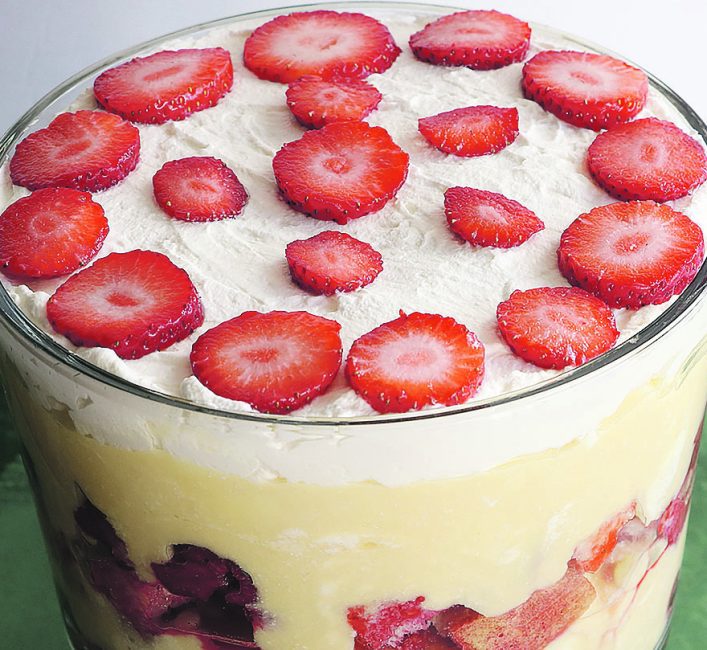
Traditional English Trifle
Serves 12.
This is a recipe Joyce Bate Cockerill Angus (1924-98) brought with her from England in 1946 as a war bride. It became a family favourite.
24 ladyfingers or nine-inch sponge cake
1/4 c. sherry or orange juice
2 tbsp. strawberry or raspberry jam
1/4 c. granulated sugar
1 pkg. frozen unsweetened strawberries, thawed300 g
1 pkg. frozen unsweetened raspberries, thawed300 g
2 c. real whipping cream
4 c. custard
1 tsp. vanilla
sliced almonds, toasted
If not using ladyfingers, cut sponge cake into thin slices or cubes. Arrange half of the lady fingers in the bottom of a large trifle or glass bowl. Spread with jam and sprinkle with half the sherry. Arrange remaining ladyfingers in bowl and sprinkle with remaining sherry.
Mix strawberries and raspberries together. Add one tablespoon of sugar and stir gently. Spoon over ladyfingers in bowl; set aside.
Beat 1/2 cup of whipping cream until light. Fold custard into whipped cream. Spoon custard mixture over fruit layer. Beat remaining whipping cream, remaining sugar and vanilla until light. Spoon over custard layer. Chill for at least three hours or overnight. Garnish with sliced, toasted almonds or sliced strawberries.
Custard
This traditional custard recipe was used alone or served with a wide variety of other dessert items such as cakes and pies, including English trifle.
4 eggs
1 c. granulated sugar
1 tsp. vanilla
3 c. milk
3 tbsp. custard powder (Bird’s Eye)
1 tsp. lemon juice
In a bowl, beat eggs and add sugar, beating until sugar has been incorporated. Add remaining ingredients, beating until well combined. Pour into a large saucepan and heat over medium-low heat, stirring constantly with a wooden spoon. If heat is too high, the custard will curdle. Slowly bring custard to a boil and continue to stir until it thickens, about 10 minutes. Let cool before using. If cooling in refrigerator, cover with plastic wrap to prevent a skin from forming.
From the Angus Family Recipe Collection courtesy of Mary Angus-Yanke, Joyce’s daughter.
Preserving their Memories
This is a few of the many books that have been written about the Canadian war brides’ experiences:
Melynda Jarratt, War Brides — The stories of the women who left everything behind to follow the men they loved.
Eswyn Lister, Most Excellent Citizens — Canada’s war brides of World War II.
Linda Granfield, Brass Buttons & Silver Horseshoes and Pier 21.
Bev Tosh, War Brides — One way passage.
Beverly Sollars, Like the Threads in Our Wedding Dress and Our Stories Entwined us in Sisterhood, Vol. 1.
Ben Wicks, Promise You’ll Take Care of my Daughter and The Remarkable War Brides of WW I.
For the names of additional books, contact Canadian War Brides and Families historian Anna-Lynn Sanche at (780) 446-2964 and leave a message.
Connecting Descendants
Canadian War Brides and Families is a volunteer, non-profit organization that connects the descendants of war brides to celebrate their mothers’ lives and share their stories.
CWB&F has yearly reunions, with the next one planned for Sept. 26-28, 2025, in Calgary. For more information, text cwb17@telus.net or phone, leaving a message, at 780-446-2964.
Seeking Dutch War Bride Stories
May 4, 2025, will be the 80th anniversary of the liberation of Holland, and Canadian War Brides and Families is gathering information about the lives of Dutch war brides in Holland during and after the war and after they settled in Canada. If you are a family member or friend of a Dutch war bride, please email CWB&F historian Anna-Lynn at liberatenl80@gmail.com.
The organization also has information about tours going to Holland for the 80th anniversary celebration.




